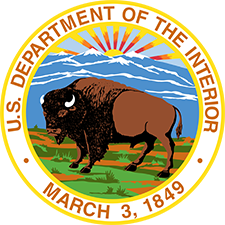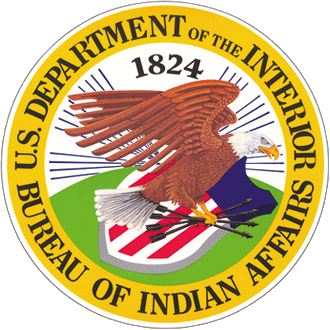News by Year
WASHINGTON – Acting Assistant Secretary – Indian Affairs John Tahsuda today announced the appointment of Charles Addington as deputy bureau director for the Bureau of Indian Affairs’ (BIA) Office of Justice Services (OJS). The appointment by BIA Director Bryan Rice became effective on December 24, 2017. Addington, a member of the Cherokee Nation, had been serving as OJS’s acting deputy bureau director since October 2, 2017.
Addington has over 25 years of law enforcement experience, 20 of which are in the management of Indian Country law enforcement programs.
PHOENIX, Ariz. – The Bureau of Reclamation and the Bureau of Indian Affairs have approved an extension lease for the Navajo Generating Station (NGS) which enables operation of the coal-fired power plant to continue through December 22, 2019. Without the extension, activities to retire the plant would be required to begin in the coming year.
WASHINGTON – U.S. Secretary of the Interior Ryan Zinke and Mark Macarro, Chairman of the Pechanga Band of Luiseño Mission Indians today signed the Pechanga Water Rights Settlement Agreement (Agreement), formally executing a Congressionally authorized pact that protects the Pechanga Band’s access to groundwater in the region and provides the tribe with more than $30 million in federal funding to pay for water storage projects.
WASHINGTON – The Department of the Interior announced today it is taking the final steps in its efforts to identify the whereabouts of approximately 17,000 Native Americans to provide compensation as part of the Cobell settlement.
WASHINGTON – Today, U.S. Interior Secretary Ryan Zinke applauded President Donald J. Trump's nomination of Tara Mac Lean Sweeney, a prominent Alaska Native leader and acclaimed businesswoman with the Arctic Slope Regional Corporation, to be the department’s next Assistant Secretary for Indian Affairs.
If confirmed by the U.S. Senate, Sweeney, a member of the Native Village of Barrow and the Iñupiat Community of the Arctic Slope, would be the first Native Alaskan and only the second woman in history to hold the position.
WASHINGTON – U.S. Secretary of the Interior Ryan Zinke today announced the selection of Bryan Rice, a veteran federal administrator and citizen of the Cherokee Nation of Oklahoma, as the new Director of the Bureau of Indian Affairs (BIA), the federal agency that coordinates government-to-government relations with 567 federally recognized tribes in the United States.
WASHINGTON – U.S. Secretary of the Interior Ryan Zinke today thanked President Trump for signing a Presidential Emergency Declaration for the Seminole Tribe of Florida, which was hard hit by Hurricane Irma last week. The tribe made its request to the Federal Emergency Management Agency (FEMA) as soon as it was able to do so. This is the first such declaration ever approved for a tribal nation according to FEMA.
WASHINGTON – The Department of the Interior announced today that the Bureau of Reclamation is awarding a construction contract of almost $62 million for part of the Navajo-Gallup Water Supply Project in New Mexico to increase the supply of clean drinking water to surrounding communities.
WASHINGTON– Today, U.S. Secretary of the Interior Ryan Zinke directed all Department of the Interior bureaus, superintendents, and land managers at all levels to adopt more aggressive practices, using the full authority of the Department, to prevent and combat the spread of catastrophic wildfires through robust fuels reduction and pre-suppression techniques.
WASHINGTON – U.S. Secretary of the Interior Ryan Zinke today announced that he has named John Tahsuda III, a member of the Kiowa Tribe of Oklahoma, as DOI’s Principal Deputy Assistant Secretary – Indian Affairs (PDAS). The appointment was effective September 3, 2017. The PDAS serves as the first assistant and principal advisor to the Assistant Secretary – Indian Affairs in the development and interpretation of policies affecting Indian Affairs bureaus, offices and programs.
WASHINGTON – U.S. Secretary of the Interior Ryan Zinke today announced the appointment of 20 primary and 18 alternate members to the Department of the Interior’s Royalty Policy Committee (Committee) that will serve a critical role in advising the Secretary on policy and strategies to improve management of the multi-billion dollar, federal and American Indian mineral revenue program. The Committee’s first meeting will be held on Wednesday, October 4.
WASHINGTON, D.C. | U.S. Secretary of the Interior Ryan Zinke is confirmed to attend the National Congress of American Indians (NCAI) 2017 Mid Year Conference & Marketplace (Mid Year) at Mohegan Sun in Uncasville, Connecticut held from Monday, June 12 to Thursday, June 15, 2017.
WASHINGTON –President Donald Trump today proposed a $2.5 billion Fiscal Year 2018 (FY18) budget for Indian Affairs, which includes the Bureau of Indian Affairs (BIA) and the Bureau of Indian Education (BIE). The President’s budget reaffirms his support of tribal sovereignty and self-determination across Indian Country by focusing on core funding and services to support ongoing tribal government operations, including an emphasis on infrastructure repair and improvements.
WASHINGTON – Secretary of the Interior Ryan Zinke issued the following statement today which was read during the 26th Annual Indian Country Law Enforcement Officers Memorial Service at the United States Indian Police Academy in Artesia, N.M. The ceremony formally announced the names of three fallen law enforcement officers from the Navajo and Chickasaw Nations as new inscriptions to the Indian Country Law Enforcement Officers Memorial Monument.
WASHINGTON – A team comprised of Southwestern Indian Polytechnic Institute (SIPI) students won the grand prize of $5,000 and the a Gold Mars Trophy for the physical competition at the 2017 NASASwarmathon held at the Kennedy Space Center. The Swarmathon is a robotics programming challenge administered under a cooperative agreement between the NASA Minority University Research and Education Program and The University of New Mexico.
WASHINGTON – Secretary of the Interior Ryan Zinke praised today’s announcement by the Department of Justice on the progress being made in coordinated federal, state, tribal and local efforts that are reducing the incidence of violent crime across the Nation.
WASHINGTON – Today, U.S. Secretary of the Interior Ryan Zinke signed two secretarial orders to advance American energy independence. The Secretary’s orders foster responsible development of coal, oil, gas, and renewable energy on federal and Tribal lands and initiate review of agency actions directed by President Trump’s executive order entitled “Promoting Energy Independence and Economic Growth.” Secretary Zinke also signed a charter establishing a Royalty Policy Committee to ensure the public receives the full value of natural resources produced from federal lands.
The Department of the Interior (Department) is considering whether to propose an administrative rule that would comprehensively update 25 CFR part 140 (Licensed Indian Traders) in an effort to modernize the implementation of the Indian Trader statutes consistent with the Federal policies of Tribal self-determination and self-governance. The current regulations were promulgated in 1957 and have not been comprehensively updated since 1965.
WASHINGTON – Acting Assistant Secretary – Indian Affairs Michael S. Black announced today that the Department of the Interior has scheduled a series of tribal consultation sessions beginning February 23, 2017, on updating the Licensed Indian Trader regulations at 25 C.F.R. Part 140. The Department is taking this action in an effort to modernize implementation of the Indian Trader statutes consistent with federal policies of tribal self-determination and self-governance.
WASHINGTON – As part of President Obama’s Generation Indigenous (“Gen-I”) initiative to remove barriers to success for Native American youth, Principal Deputy Assistant Secretary – Indian Affairs Lawrence S.
WASHINGTON – Principal Deputy Assistant Secretary – Indian Affairs Lawrence S. Roberts today issued an updated Contract Support Costs (CSC) Policy for the Indian Affairs Manual (IAM). The updated Policy reflects extensive tribal consultation and the work of the Bureau of Indian Affairs’ (BIA) CSC Workgroup, which is comprised of tribal and federal experts.
WASHINGTON - Principal Deputy Assistant Secretary – Indian Affairs Lawrence S. Roberts, who leads the Office of the Assistant Secretary – Indian Affairs, today announced the Department’s decision to place a 1.08-acre land parcel owned by the Craig Tribal Association, a federally recognized tribe headquartered in the City of Craig, Alaska, into federal Indian trust status.
indianaffairs.gov
An official website of the U.S. Department of the Interior


